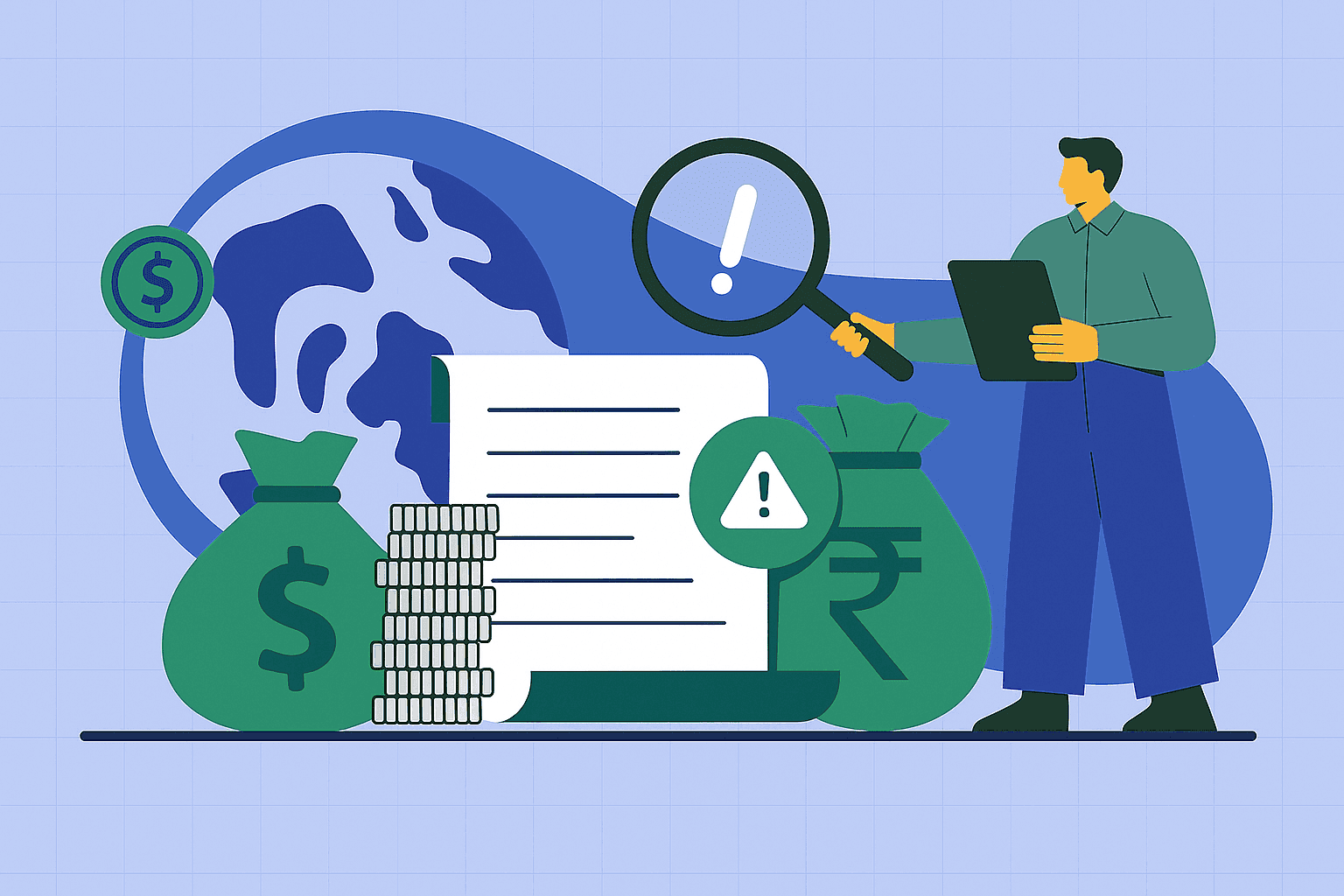Negotiating International Payment Terms: A Complete Guide for Indian Exporters & Freelancers

When you work with overseas clients, getting paid on time can make or break your business. That’s where international payment terms come in. They define when and how you receive money, whether you’re an exporter shipping goods abroad or a freelancer delivering services online.
In international business and trade, payment terms protect your cash flow, reduce risk, and set clear expectations with clients. Yet many Indian exporters and freelancers struggle to negotiate terms that balance client comfort with financial security. This guide explains the most common payment terms, negotiation strategies, and tools that make them work in practice.
Most Common International Payment Terms
Before you can negotiate better terms, you need to understand what these international payment terminologies mean:
Net 15 / 30 / 60 (Standard International Payment Terms in Trade)
It means your client pays within that many days after receiving your invoice. SaaS companies and B2B exporters love these terms because they're predictable. Net 15 keeps your cash flowing quickly, while Net 60 might work for established clients, but it can strain smaller businesses that are waiting for payment.
Advance Payment (Best for New International Clients)
Partial Upfront + Milestones (Freelancer-Friendly Payment Terms in International Business)
It gives you the best of both worlds. Consider asking for 30% upfront, then 40% at project midpoint, and 30% on completion. Freelancers and service agencies utilize this approach because it strikes a balance between cash flow and client comfort. The client doesn't pay everything up front, but you're not waiting months for a single large payment.
Letter of Credit (LOC in International Trade)
It is like having a bank guarantee your payment. The client's bank promises to pay you once you meet specific conditions. It's common in high-ticket export deals because it protects both parties, though it involves more paperwork and bank fees.
LOC is like having a bank guarantee your payment. The client's bank promises to pay you once you meet specific conditions. Suppose you're exporting handcrafted furniture worth $25,000 to a buyer in Australia. With a letter of credit, their bank guarantees payment once you provide documents proving you've shipped the goods according to agreed specifications.
This method is standard in high-ticket export deals because it protects both parties - you know you'll get paid, and they know you'll deliver as promised. However, it involves more paperwork, such as bills of lading, commercial invoices, and inspection certificates, which must match the letter of credit terms exactly. Banks typically charge 0.1% to 2% of the transaction value for issuing and processing these documents, plus additional fees for amendments or document handling.
Open Account (Long-Term Exporter Payment Term)
This means you ship first and trust the client to pay later, usually on Net 30 or 60 terms. This works when you have solid, long-standing relationships where trust has been built over multiple successful transactions.
This means you ship first and trust the client to pay later, usually on Net 30 or 60 terms. For example, if you've been supplying organic spices to the same German distributor for three years and they've never missed a payment, you might ship their monthly $15,000 order and invoice them to pay within 30 days.
This works when you have solid, long-standing relationships where trust has been built over multiple successful transactions. The benefit is minimal paperwork and lower transaction costs since there are no bank guarantees or escrow fees involved.
However, if the client defaults, you have limited recourse beyond legal action, which can be expensive and time-consuming across international borders.
Factors to Consider Before You Negotiate Terms
Entering payment negotiations without preparation can significantly impact your business. You need to understand your and your client’s positions before making your first move.
Start with your client's profile
A Fortune 500 company in the US operates differently from a startup in Brazil. Large corporations often have rigid 60-day payment cycles because that's how their accounting departments work, while smaller companies might be more flexible but potentially riskier.
Check their payment history - a client who consistently pays invoices late is unlikely to change just because you ask nicely.
The country matters too. German businesses are generally punctual with their payments, although some regions have cultural norms that allow for longer payment cycles. This isn't stereotyping - it's understanding the business environment you're entering.
Contract size changes everything
A $500 logo design and a $50,000 software development project deserve different payment structures. Larger contracts give you more negotiating power because the client has more at stake, but they also justify more complex milestone-based payments that protect both parties.
Your own cash flow situation is crucial
If you're bootstrapping a growing team and need steady income for salaries, pushing for shorter payment terms or upfront payments isn't being demanding - it's being responsible. Know your minimum viable payment schedule before you start negotiating.
Currency volatility can quietly eat your profits
If you're pricing in USD but your costs are in rupees, a sudden exchange rate shift during a 60-day payment period could wipe out your margins. Here's how this plays out: imagine you quote a project at $10,000 when the exchange rate is 83 rupees per dollar, expecting to receive ₹8,30,000. You factor in costs of ₹6,00,000, leaving you a healthy ₹2,30,000 profit margin.
But if the rupee strengthens to 80 per dollar by the time payment arrives two months later, you'll only receive ₹8,00,000 - suddenly, your profit has dropped to ₹2,00,000. That's a ₹30,000 loss just from currency movement, which represents 13% of your expected profit vanishing due to timing.
This risk becomes even more significant with larger contracts or longer payment cycles. A 3-4 rupee fluctuation might seem small, but on a $50,000 project, it could mean losing or gaining ₹1,50,000 to ₹2,00,000. Factor this volatility into your term preferences by either negotiating shorter payment cycles, incorporating currency buffers into your pricing, or considering rupee-based pricing for domestic costs when dealing with international clients.
These considerations are critical when setting payment terms in international business because they directly impact risk, profitability, and long-term client trust.
3 Smart Negotiation Techniques that Always Work
The best negotiation techniques make it easy for clients to say yes. Think of negotiation as problem-solving together rather than arm-wrestling over contract details.
Give your clients choices instead of ultimatums
Instead of demanding "50% upfront or no deal," try something like "I typically work with either 50/50 split payments or milestone-based terms - which feels more comfortable for your budgeting process?"
This approach allows clients to feel in control while you still secure favorable terms. Most people prefer having options rather than being backed into a corner, and you're more likely to get a yes when clients feel they're making a choice rather than being forced.
Make better payment terms feel like upgrades, not penalties
When you say "We offer priority turnaround and dedicated support for projects with upfront payment," you're positioning faster payment as a premium service rather than making slow payment seem like the default.
Clients start thinking about what they gain from paying quickly instead of what they lose from paying slowly. You could offer faster delivery, more revisions, or priority scheduling - benefits that cost you little but add value for them.
Use industry standards as your negotiating foundation
Research what other freelancers and exporters in your field typically charge and what payment terms they use. When you say "Most agencies in our space work on 30% upfront, 70% on delivery," you're not being pushy - you're showing market norms.
Clients often don't know what's standard, so providing that context helps them understand your terms aren't unusual requests.
Tools to Enforce and Secure Payment Terms
Having great payment terms on paper means nothing if you can't enforce them. Think of these tools as your safety net:
Start with bulletproof contracts that leave no room for confusion
Your contract should clearly outline when payment is due, what happens if it's late, and what constitutes project completion. Include phrases like "Payment due within 15 days of invoice date" rather than vague terms like "payment due soon."
Add late fee clauses that kick in automatically - something like "1.5% monthly charge on overdue amounts" gives clients a real incentive to pay on time. Bold the due date on every invoice and make your payment terms impossible to miss.
Payment platforms can transform how you handle international transactions, especially for Indian exporters and freelancers
Take Skydo, which has become popular among Indian businesses working globally. Instead of losing 8-9% of your payment to traditional banks or payment gateways, Skydo offers zero foreign exchange margins with flat fees - just $19 for payments up to $2,000 and $29 for payments between $2,001 and $10,000.
You get global bank accounts in countries like the US, UK, and Canada within minutes, so clients can pay you locally while you receive money in India. The platform handles FIRA compliance automatically and provides real-time payment tracking, eliminating the need to wonder whether your German client sent a payment three weeks ago.
For freelancers using Upwork, the built-in escrow system holds client funds until project milestones are met, protecting both parties.
Automation removes the awkwardness from payment follow-ups
Platforms like FreshBooks or QuickBooks can send automatic payment reminders at intervals you set - perhaps a friendly reminder at 7 days overdue, then a firmer notice at 15 days. This way, you're not personally chasing payments or damaging client relationships with uncomfortable conversations.
Make your invoice terms impossible to ignore with smart formatting
Bold your due date in a larger font so it jumps off the page - something like "Payment Due: March 15, 2025" rather than burying it in paragraph text. Display late fees prominently near the total amount, rather than hiding them in fine print at the bottom.
Use phrases like "Late fee of 1.5% per month applies to overdue balances" right under your payment total. Consider adding a small box or highlight around critical payment information so clients can't claim they missed these details later.
Among the modern tools for managing international payment terms, platforms like Skydo stand out for Indian exporters and freelancers. They combine compliance (FIRA, eBRC), cost savings (zero forex margins, flat fees), and faster settlement times into one system. This makes them especially relevant when negotiating payment terms in international trade.
What to Do if Clients Push Back
Pushback on payment terms isn't personal rejection - it's usually about unfamiliarity or past bad experiences. The key is addressing their concerns while protecting your business needs.
Frame your requirements around mutual benefits rather than your personal situation
Instead of saying "I need upfront payment because I have bills to pay," try "Due to currency volatility and international transfer delays, milestone-based payments help us maintain consistent service quality and meet your project deadlines."
This shifts the conversation from your financial needs to their project success. Clients care more about their outcomes than your cash flow challenges, so connect your payment terms to delivering better results for them.
When clients seem hesitant about your terms, suggest starting smaller to build trust
If a potential client is hesitant about 50% upfront for a $10,000 project, offer to do a smaller $2,000 test project first with your standard terms. Once they see your work quality and reliability, they're usually more comfortable with larger commitments and better payment structures.
This approach turns sceptical prospects into long-term clients who eventually prefer working with you over competitors who might offer looser terms but inconsistent delivery.
The goal isn't winning every negotiation - it's finding clients who value quality work and understand that good payment terms enable better service.
Make the Most of Your Payments with Skydo
Smart international payment terms aren’t just contract clauses; they’re the foundation of successful cross-border business. For Indian exporters and freelancers, aligning with industry standards, protecting against currency risks, and using trusted payment platforms ensures smooth operations.
That’s why solutions like Skydo matter. By offering transparent fees, local collection accounts in the US/UK/Canada, and built-in compliance, Skydo helps Indian businesses negotiate from a position of confidence in international trade.
What are international payment terms?
They are agreements between buyers and sellers that specify when payments are due, how they will be made, and in what currency. Examples include advance payments, net 30, and letters of credit.
What payment terms are standard in international trade?
Which payment terms are safest for exporters and freelancers?
How can Indian exporters negotiate better payment terms?












